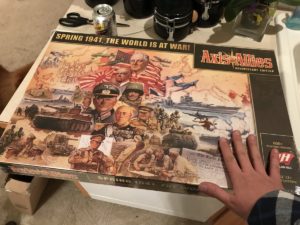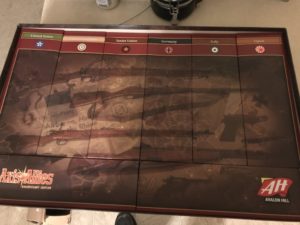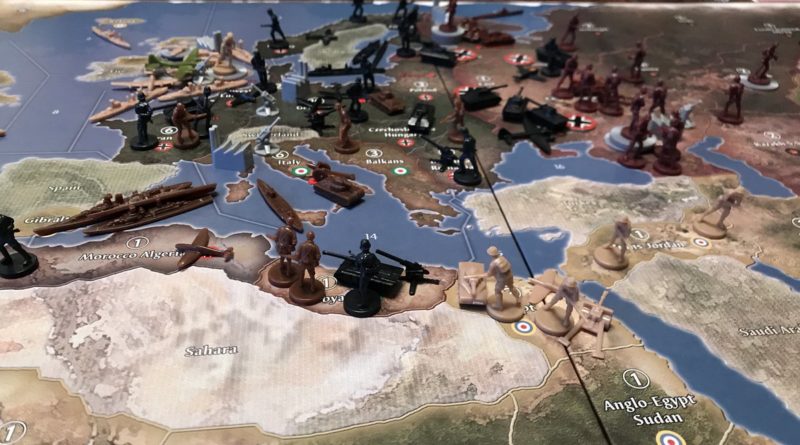Board Game Review: Axis & Allies Anniversary Edition

Axis & Allies Anniversary Edition is an incredible piece of work. No need to bury the lede there.
Axis & Allies stands out as a formative game from my childhood. After playing Risk for years with my family, sitting down at the age of 14 with my older brother and his friends and playing an all-day game of this both sparked my interest in history and board gaming. I know it was a formative experience for many others as well.
Arriving at my doorstep in a massive box, the game is immediately striking. Brand new art from the artist of the original Axis & Allies box cover, Jim Butcher, displays the forces at work in the war. It’s visually stunning and very evocative.

Once you crack open the box, you’ll find a series of boxes laid out to form a larger image. Each nation gets their own box with their tokens and plastic units. The other two boxes contain the bank notes, factories, dice and neutral anti-aircraft weapons. This was a fantastic move on their part, because it allows the players to easily keep their pieces sorted, and makes for very fast pre-game prep and post-game cleanup.
The board is three massive pieces, each as large as the box itself. Make room at the table for this monstrosity, because it takes up a ton of space. I had to add in leaves to my oak table to make room for the whole game. It’s all very well laid out and easy to read.
The mechanics are pretty straight forward: Players set up the board according to one of two possible setups (1941 and 1942). Each setup will dramatically change the strategy to the game, placing certain nations at an advantage. We chose the 1941 setup. You place specific units at specific locations in order to simulate the strength of forces at the time. On your turn, you will spend your money on new units, which you won’t be able to use until you place them at the end of the turn. Meanwhile, you’ll be moving your troops to seize territory and push back against the opposing powers. Combat works like Risk, in a way, but with different units having different required roles depending on if they’re attacking or defending. All of the rules are fairly straight forward, and most units have special rules to mix things up.
A mechanic that was introduced in more recent years is that the game ends once you’ve captured a certain number of cities. The Allies begin with more cities under their control, making it easier to win, but the cities they still need to capture are incredibly difficult to take. The Axis have the uphill battle of pushing out to capture more cities than the Allies need to win, but risk weakening their fortress nations.
I gathered three friends, Liam, Liz, and Ryan, to join me for a day of play. I warned them beforehand (none had played before) that the game was long, so they brought along snacks and we made a day out of it.
Liam and Liz took on the role of the Axis, with Liam playing Japan and Italy, while Liz played the German powers. Ryan played the British and Russians, while I played the Americans and the Chinese forces.
(Quick note: There is a seventh faction in the Chinese, with their own color troops, but they only have infantry, and generally serve as a blockade to slow down the Japanese forces in East Asia. The American Forces usually play them.)
Right off the bat, we didn’t have much of a strategy. I hoped to get forces built up to help clean up the Pacific, while Ryan wanted to push the Germans out of Africa to gain a foothold there, and try to punch through the German lines in Europe as the Russians to try to form a strong defensive blockade to hold back the Nazi invasion of Russia. Nothing went according to plan.
The Germans immediately hurled their forces at Russia, punching through Russian fortifications, and really worrying us. If the Germans seized the factories set up by Ryan, they would be much more dangerous to the world at large. I began building troops in the Eastern US and prepared to get them shuttled over to Europe as a staging ground. I just needed Ryan to drive out the Italian and German forces in Africa.
Over in the Pacific, the Japanese seized a few islands, while I began building destroyers and battleships to fight back. While I did serve on a carrier, I found they weren’t as effective as I would have liked, so I focused my efforts on the other ships. I managed to get my forces close to Japan, within striking distance, worrying Liam.
The Italians built up a large force in the Mediterranean, making the invasion through the Straits of Gibraltar all but impossible, and the British forces weren’t doing well against the Axis in Africa either.
After 6 hours of play, with Liz draped across multiple chairs in exhaustion, we decided to make a final push and end the game in one more turn. We were four turns in. Shockingly, we knocked out our final turn in only a half hour. How? Turns out, we had been talking and joking so much, rather than being intently focused on the game, that the turns drug on for an hour or more. When you really put your mind to it, you can quite easily blaze through a turn.
In the end, we ended the game prematurely, but counted up the number of cities each side had captured. The Allies won, but barely.
I love this game. If you’re looking for something more in-depth than Risk, but aren’t quite ready to go into the much more complicated world of war gaming, Axis & Allies is the way to go.
Dice Monkey was provided a copy of Axis & Allies: Anniversary Edition from Wizards of the Coast/Avalon Hill for review.

